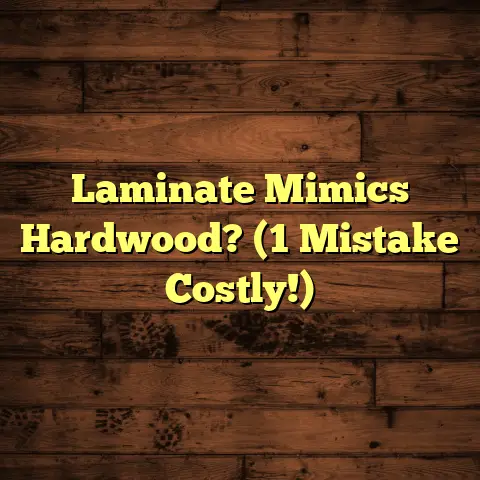Concrete vs. Tile Costs (AU)? (2 Budget Busters!)
Choosing new flooring can feel like picking the perfect outfit for a big event.
You want something that looks great and reflects your style, but it also needs to be practical and, of course, fit your budget.
Just like that dream outfit, flooring can quickly turn into a budget buster if you’re not careful!
I’ve seen it happen time and time again in my years as a flooring contractor here in Australia.
So, let’s dive into the world of concrete and tile flooring, break down the costs, and uncover those sneaky budget busters that can trip you up.
Section 1: Overview of Concrete and Tile Flooring
Concrete Flooring: The Modern Marvel
Concrete flooring has become incredibly popular.
It’s not just for warehouses anymore!
We’re seeing it everywhere, from modern homes to trendy cafes.
It’s basically a mixture of cement, aggregates (like sand and gravel), and water.
But what makes it so versatile?
Well, you can polish it to a high shine, stain it in a rainbow of colours, or even stamp it with patterns.
Think sleek, minimalist grey, warm earthy tones, or even a faux-tile look.
One of the big draws of concrete is its durability.
It can handle a lot of foot traffic and is resistant to scratches and stains.
Maintenance is pretty straightforward too – regular sweeping and occasional mopping usually do the trick.
Tile Flooring: The Timeless Classic
Tile flooring is a classic for a reason.
It’s been around for centuries and offers a huge range of options.
You’ve got ceramic, porcelain, natural stone (like marble and granite), and even glass tiles.
Each type has its own unique characteristics and price point.
-
Ceramic tiles are generally the most affordable and come in a wide variety of styles.
-
Porcelain tiles are denser and more durable than ceramic, making them a great choice for high-traffic areas and wet areas like bathrooms.
-
Natural stone tiles offer a luxurious look and feel, but they also come with a higher price tag and require more maintenance.
Tile is known for being waterproof and easy to clean, which is why it’s so popular in kitchens and bathrooms.
Plus, the design possibilities are endless!
You can create intricate patterns, mimic wood flooring, or go for a bold, colourful statement.
Concrete vs. Tile: Popularity in Australia
Both concrete and tile are popular choices in Australia, but there are some regional preferences.
In warmer climates like Queensland and Western Australia, tile is often favoured for its cooling properties.
Concrete is gaining traction in more design-focused areas like Melbourne and Sydney, where its modern aesthetic is highly sought after.
According to a recent survey by statista.com, hard surface flooring like tiles and concrete accounts for a significant portion of the Australian flooring market.
Section 2: Cost Breakdown of Concrete Flooring
Alright, let’s talk numbers.
I know that’s what you’re really here for!
The cost of concrete flooring can vary quite a bit depending on several factors.
Material Costs: Finishes and Square Meters
The biggest factor influencing material costs is the finish you choose.
Here’s a rough breakdown of prices per square meter:
-
Polished concrete: \$80 – \$150 per square meter.
-
Stained concrete: \$70 – \$120 per square meter.
-
Sealed concrete: \$60 – \$100 per square meter.
These prices are just estimates, and they can fluctuate based on the complexity of the job and the specific products used.
For example, using a high-end stain or sealant will obviously increase the cost.
Installation Costs: DIY vs. Professional
Installation costs are another big piece of the puzzle.
You might be tempted to DIY concrete flooring to save money, but I generally advise against it, especially if you’re not experienced.
Concrete work is physically demanding and requires specialized tools and knowledge.
Plus, mistakes can be costly to fix!
Professional installation typically costs between \$50 and \$100 per square meter, on top of the material costs.
Factors that affect labor costs include:
-
The size of the area: Larger areas usually have a lower per-square-meter cost due to economies of scale.
-
The complexity of the design: Intricate patterns or multiple stain colours will increase labor time.
-
The condition of the existing subfloor: If the subfloor needs significant preparation, that will add to the cost.
Maintenance and Longevity: The Long Game
One of the great things about concrete flooring is its longevity.
With proper maintenance, it can last for decades.
However, there are still some long-term costs to consider.
-
Sealing: Concrete needs to be sealed periodically (every 1-3 years) to protect it from stains and moisture. This typically costs around \$10 – \$20 per square meter.
-
Repairs: While concrete is durable, it can crack over time, especially if the subfloor shifts. Repairing cracks can range from a few hundred dollars for minor fixes to several thousand for more extensive damage.
-
Refinishing: If the surface becomes worn or scratched, you may need to refinish the concrete. This involves grinding down the surface and re-polishing or re-staining it. Refinishing can cost between \$50 and \$100 per square meter.
Section 3: Cost Breakdown of Tile Flooring
Now, let’s switch gears and look at the costs associated with tile flooring.
Material Costs: A World of Options
Tile flooring offers a staggering array of options, and the price range reflects that.
Here’s a general idea of what you can expect to pay per square meter for different types of tiles:
-
Ceramic tiles: \$20 – \$80 per square meter.
-
Porcelain tiles: \$30 – \$100 per square meter.
-
Natural stone tiles (e.g., marble, granite): \$80 – \$300+ per square meter.
-
Specialty tiles (e.g., glass, mosaic): \$50 – \$500+ per square meter.
The aesthetic implications are huge.
You can create a budget-friendly bathroom with simple ceramic tiles or splurge on a luxurious marble floor for your entryway.
Keep in mind that the price can also vary based on the size, shape, and pattern of the tiles.
Larger tiles generally cost more per square meter but can be quicker to install.
Installation Costs: Professional vs. DIY
Like concrete flooring, tile installation can be a DIY project, but it’s not for the faint of heart.
Tiling requires precision and patience.
You need to be able to cut tiles accurately, lay them evenly, and grout them properly.
If you’re not confident in your abilities, it’s best to hire a professional.
Professional tile installation typically costs between \$40 and \$80 per square meter, in addition to the material costs.
Challenges that may arise during the process include:
-
Uneven subfloors: This is a common problem, and it can require extra work to level the floor before tiling.
-
Complex patterns: Intricate patterns require more time and skill to install.
-
Cutting tiles around obstacles: Cutting tiles around pipes, toilets, and other fixtures can be tricky.
Maintenance Considerations: Cleaning and Repairs
Tile flooring is generally easy to maintain.
Regular sweeping and mopping are usually all that’s needed.
However, there are some maintenance considerations to keep in mind:
-
Grout: Grout can become stained and discoloured over time. It needs to be cleaned regularly and may need to be resealed every few years.
-
Cracked or chipped tiles: Tiles can crack or chip if they’re subjected to heavy impact. Replacing a tile is usually a relatively simple repair, but it can be difficult to match the existing tiles perfectly.
-
Natural stone: Natural stone tiles require special cleaning products and may need to be sealed more frequently than ceramic or porcelain tiles.
Section 4: Budget Busters in Concrete Flooring
Okay, let’s get down to the nitty-gritty.
What are the biggest budget busters you need to watch out for with concrete flooring?
Based on my experience, here are two that can really throw a wrench in your plans:
1. Unexpected Installation Costs: Subfloor Woes
One of the most common budget busters is unexpected subfloor preparation.
Concrete flooring needs a solid, level subfloor to prevent cracking and ensure a smooth finish.
If your existing subfloor is uneven, damaged, or contaminated, it will need to be repaired or replaced before the concrete can be poured.
This can add significantly to the overall cost.
I’ve seen subfloor repairs add thousands of dollars to a project, especially in older homes.
The best way to avoid this is to have a thorough inspection of the subfloor before you commit to concrete flooring.
A good contractor will be able to identify any potential problems and give you an accurate estimate of the cost to fix them.
2. Repair and Refinishing Costs: The Price of Neglect
While concrete is durable, it’s not indestructible.
If it’s not properly sealed and maintained, it can become stained, scratched, and even cracked.
Repairing these issues can be expensive, especially if the damage is extensive.
As I mentioned earlier, refinishing concrete involves grinding down the surface and re-polishing or re-staining it.
This is a time-consuming and labour-intensive process, and it can cost just as much as the initial installation.
To avoid these costs, it’s crucial to seal your concrete flooring properly and maintain it regularly.
This means sweeping and mopping regularly, cleaning up spills promptly, and reapplying sealant as needed.
Section 5: Budget Busters in Tile Flooring
Now, let’s take a look at the budget busters that can plague tile flooring projects.
1. High Material Costs for Specialty Tiles: The Luxury Tax
As I mentioned earlier, the price of tile can vary widely depending on the type of material.
Opting for premium tiles like natural stone, glass, or mosaic can significantly inflate the overall budget.
Natural stone tiles, in particular, can be incredibly expensive.
Not only do they cost more per square meter, but they also require special installation techniques and maintenance products, which adds to the cost.
I’ve seen homeowners fall in love with a particular type of natural stone only to be shocked by the price tag.
Before you get your heart set on a specific tile, be sure to get a quote for the material costs and installation.
You might be surprised at how quickly the price can add up.
2. Subfloor Preparation and Repair Costs: The Foundation of Success
Just like with concrete flooring, subfloor preparation is crucial for a successful tile installation.
An uneven subfloor can cause tiles to crack, shift, and even pop up over time.
If your subfloor is not level, you’ll need to use leveling compounds or additional underlayment to create a smooth, even surface.
This can add significantly to the cost of the project.
In some cases, the subfloor may need to be completely replaced, which can be a major expense.
Again, a thorough inspection of the subfloor is essential before you start tiling.
A good contractor will be able to assess the condition of the subfloor and give you an accurate estimate of the cost to prepare it for tiling.
Section 6: Comparative Summary
Okay, let’s put it all together and compare the costs of concrete and tile flooring side-by-side.
| Feature | Concrete Flooring | Tile Flooring |
|---|---|---|
| Material Costs | \$60 – \$150+ per square meter | \$20 – \$500+ per square meter |
| Installation Costs | \$50 – \$100 per square meter | \$40 – \$80 per square meter |
| Subfloor Prep | Potentially high, depending on condition | Potentially high, depending on condition |
| Maintenance | Sealing, occasional repairs | Grout cleaning, potential tile replacement |
| Longevity | Decades with proper care | Decades with proper care |
| Budget Busters | Subfloor issues, repair/refinishing | Specialty tiles, subfloor issues |
As you can see, both concrete and tile flooring have their own unique cost considerations.
Concrete flooring can be more expensive upfront, especially if you choose a high-end finish or need extensive subfloor preparation.
However, it can be very durable and long-lasting with proper maintenance.
Tile flooring offers a wider range of price points, but specialty tiles can be incredibly expensive.
Subfloor preparation is also a critical factor to consider.
Ultimately, the best choice for you will depend on your budget, style preferences, and practical considerations.
If you’re on a tight budget, ceramic tiles might be the way to go.
If you’re looking for a modern, minimalist look and are willing to invest in proper maintenance, concrete flooring could be a great option.
Conclusion
Choosing between concrete and tile flooring is a big decision.
It’s important to understand the full financial picture before you make a commitment.
Both options have their merits and pitfalls, but being informed about potential budget busters can lead to more strategic and cost-effective choices in the long run.
Don’t be afraid to ask questions, get multiple quotes, and do your research.
With a little planning and forethought, you can choose the perfect flooring for your home without breaking the bank!
And remember, I’m always here to help if you need some expert advice.





